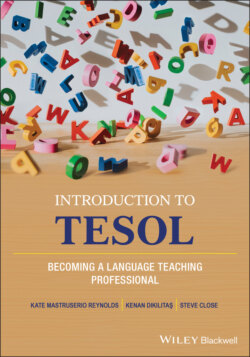Читать книгу Introduction to TESOL - Kate Reynolds - Страница 17
Heterogeneous or homogeneous learner populations
ОглавлениеIn some classrooms, there may be students who speak many different languages. For example, in New South Wales, Australia, there are 239 different languages spoken in the public schools as of 2018 (CESE Bulletin, 2018). Students may speak Chinese, Arabic, Vietnamese, Tagalog, Samoan, or Greek. We call this a heterogeneous class due to the different languages.
In other language settings, there may be classes with students who all speak the same language. This class composition is called a homogeneous population, because they share a similar first language. These distinctions are important, because the types of activities a teacher may use differ if they all share a language.
Generally, there are more heterogeneous class compositions in second language settings and more homogeneous groups in foreign language contexts. However, there are always exceptions to this pattern.
ESOL stands for English to speakers of other languages. The contexts for ESOL are similar to ESL—contexts where the language used outside of the classroom is English. This acronym was introduced to explicitly alleviate a problem, which was that the acronym ESL implied studying English as a “second,” not “additional,” language. ESOL implies students may speak more than one other language.
ESOL was adopted by several U.S. states in their laws and by TESOL International Association and its affiliates in their names. For example, Washington Association for the Education of Speakers of Other Languages (WAESOL) (https://waesol.org) and Peru Teachers of English to Speakers of Other Languages (http://www.perutesol.org).
EFL represents English as a foreign language. It describes the study of English in contexts where the language used outside of the classroom is not English. Often the language employed outside of the classroom is the students’ primary language. For example, the study of English in countries such as China, Japan, Saudi Arabia, Thailand, Ukraine, and the United Arab Emirates.
There are some inherent issues with the use of EFL. EFL is one of the older acronyms to describe the study of English. With the use of the world “foreign,” it has a negative connotation of otherness or oddity. In the field of TESOL, we hope to bridge cultural differences, so emphasizing otherness is counterproductive.
Despite the anachronistic nature of some of these acronyms, they do provide a clear distinction in context, which provides insiders with information about the amount of language practice and practice opportunities, and duration and type of instruction. For example, in Japan, elementary school children have English class for a couple of hours per week in which they learn basic vocabulary for families, food, hobbies through games and song. By middle and high school, students have English class daily, in which they learn speaking, listening, reading, and writing through choral drills, oral presentations, readings, interactive activities, and games. Much of the learning is about memorization and repetition. The classroom formats generally revolve around the teacher. The teacher asks a question and calls upon a student, for example. We call this teacher-centered interaction. For example, students in Japan may access outside-of-class opportunities to develop their oral language skills on the internet, but interaction within the community in English is not necessary, and often not even possible. Because of this and other factors, Japanese English learners tend to struggle with their oral language proficiency. This example is not intended to demonize the instruction of English in Japan. Actually, there are many exciting, culturally congruent practices employed by knowledgeable educators in Japan. These are generalizations to illustrate associations common with the EFL setting only. Although these are generalizations, generalizations are valuable at times.
